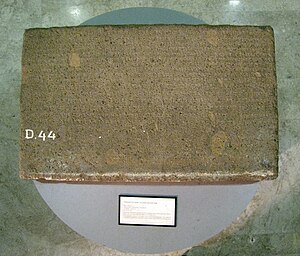Kelurak inscription

Kelurak inscription, displayed at National Museum of Indonesia, Jakarta
|
|
| Material | Andesite stone |
|---|---|
| Writing | Pranagari script in Sanskrit |
| Created | 700 Saka (778 CE) |
| Discovered | Lumbung temple in Kelurak village, Klaten Regency, located not far north of Prambanan temple, Central Java, Indonesia |
| Present location | National Museum of Indonesia, Jakarta |
| Registration | D.44 |
The Kelurak inscription is an inscription dated 704 Saka (782 CE), written in Sanskrit with Pranagari script, discovered near Lumbung temple in Kelurak village, located not far north of Prambanan temple, Central Java, Indonesia.
The writings on the inscription was discovered in poor condition with several parts are unclear and unreadable, as the result historians only could translate the main information of the inscription.
The inscription mentioned about the construction of a sacred buddhist building to house the Manjusri statue that contain the wisdom of Buddha, dharma, and sangha; the same trinity as Brahma, Vishnu and Maheshvara. The construction of this sacred building was ordered by King Indra, revered in his official name Sri Sanggramadhananjaya. The reference to Hindu gods in this Buddhist temple signify the Tantrayana—Vajrayana buddhism influence. The temple dedicated to Manjusri is identified as Sewu temple, located not far north from Prambanan temple.
Today the inscription is displayed in National Museum of Indonesia, Jakarta, under the inventory number No. D.44.
...
Wikipedia
